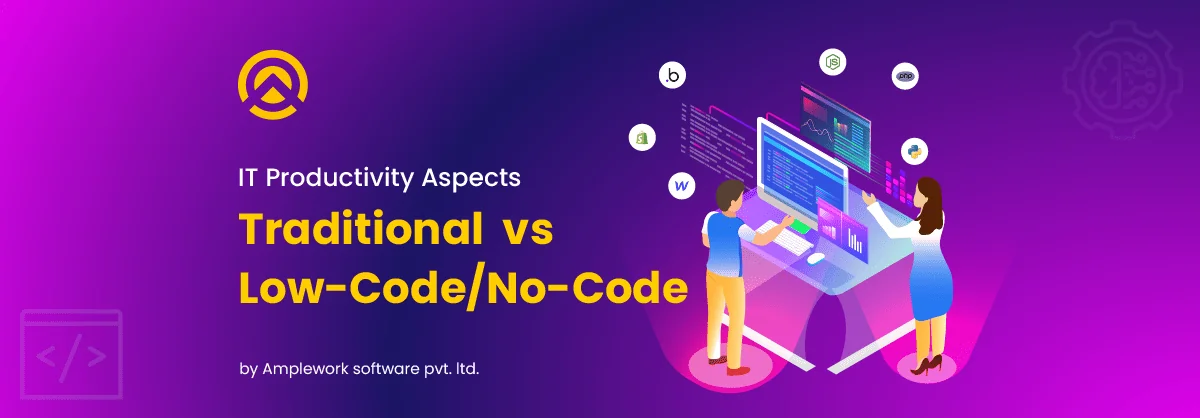Transformation is the key aspect of moving toward advancement. The technical development of the software has changed a lot with various advancements in recent years. In this field of software development, traditional coding has been a dominating approach for designing different software solutions. Traditional development processes majorly worked with the asset of manual coding.
Blog Motive
The motive of this blog is to deliver the best possible comparative measures of the Traditional vs. Low-Code No-Code software development practices. Give it a quick read to analyze which is the best software-developing way for your business to be up to date with the advancements. Where both the development terminologies have valuable pointers.

Software development has now become a major field of economic growth and from this perspective, business organizations prefer innovation over traditional solutions. As we can see in the table mentioned below stating the revenue criteria of Low-Code Development. The revenue expectation of these techniques is to generate $26.9 billion in 2023 on a worldwide scale. This development of low code scale involves techniques mentioned in the tabular.
| Technologies | 2021 | 2022 | 2023 | 2024 |
| Low-Code Application Platforms (LCAP) | 6,324 | 7,968 | 9,960 | 12,351 |
| Business Process Automation (BPA) | 2,416 | 2,585 | 2,761 | 2,940 |
| Multi Experience Development Platforms (MDXP) | 2,081 | 2,508 | 2,999 | 3,563 |
| Robotic Process Automation (RPA) | 2,350 | 2,892 | 3,401 | 3,879 |
| Integration Platform as a Service (iPaaS) | 4,680 | 5,668 | 6,668 | 7,838 |
| Citizen Automation and Development Platforms (CADP) | 554 | 732 | 953 | 1,232 |
| Other Low-Code Development (LCD)Technologies | 92 | 109 | 126 | 146 |
| Total | 18,497 | 22,462 | 26,869 | 31,949 |
In recent innovative terms. Developers preferred Low-Code/ No-Code (LCNC) over other sources. It defined as a Rapid Application Development approach (RAD). That utilizes visual building blocks like pull-down and drag-and-drop menu interfaces for automated code generation. No-Code is also termed as a RAD approach and denoted as a subset of modular plug-and-play of the Low-Code approach.
Traditional Terminologies of Software Development
The traditional technology of software development initiated the era of IT development and worked towards managing different innovative integrations over time. This software development technique works on writing code from scratch for the creation of variants like software solutions, applications, and systems. Highly skilled programmers are the main asset of this technique.

The development of software solutions with these techniques requires proper working practices to deal with factors like complexity, teamwork for large projects, and different stages of development processing such as backend development, frontend development, quality assurance, and proper database management.
Beneficial Aspects
- Traditional development worked on establishing the roots of software development and holds various beneficial aspects. Development of complex applications is only preferred with traditional technologies. With the use of traditional application development, the IT product can adopt different customization, performance optimization, secure platform, ownership, high-level specialization, complete control, and innovation with complexity.
- With traditional development practices, the final software product can be scaled at its best as the application gets developed from the initial level. This is considered an independent factor for not getting dependent on any pre-developed structures.
- Applications with traditional concepts are developed all over from scratch which gets converted in the advantage of getting the whole ownership of the final software product.
Non-Beneficial Aspects
- The initial requirement of the traditional software process is the effective contribution of highly skilled employees. As this type of development process is way too complex and needs to be implemented with proper functionalities with the presentive assistance of an experienced developer. Lacking the experienced skill set is identified as a backlog in traditional software development.
- Development of these custom software solutions is costly or mandates contributions of the high budget which is not possible for every inventor to arrange.
- Along with these traditional methods hold a limited scale when it comes to qualities like syncing with other platforms, and various customization.
Software Development Low-Code/ No-Code Approach
With the advancement of technology, the software development process got revolutionized with many perfections or flexibilities. In these advanced flexibilities, Low-Code/No-Code development is recognized as an easy alternative to traditional development processes. Being a RAD approach both these development processes avail different aspects for flexibility.

These aspects are easy development, drag-drop interfacing, secure development, a product with mobility, amicable scalability, low-cost investment, easy cross-platform accessibility, and availability of pre-built templates. The most significant quality that comes in-built within these approaches is they can be adaptable to the frequently changing nature of the development processes.
Beneficial Aspects
- With the use of Low-Code/No-code approaches the development process becomes simple as it involves drag-and-drop functionality and visual guidance which is utilized as a proper replacement for heavy traditional programming.
- With the implementation of these modernized techniques, the developer can interact with the system itself and work towards commanding the system to program software.
- When it comes to speed and accuracy, these approaches deliver the best quality software outcomes with all the possible innovative features of future needs.
Non-Beneficial Aspects
- The use of specific tie-ups with vendor service providers, this low-code/no-code software development limits the developers with the whole ecosystem of the vendor. In this scenario, the integration of the main development domain becomes difficult to organize.
- The abstraction of underlying code and infrastructure comes out to be a major issue of this development technique. This aspect makes the developers do not have complete control over the development of applications.
- In any software development technique upgradation and maintenance plays a major role and in No-Code/Low-Code practices this can rise as a big hurdle. The process of updating these platforms can face issues like sudden disruptions and compatibility issues.
Comparative Measures of Traditional & Recent Development Techniques

1. Speed Criteria
Traditional development techniques lack the newly invented techniques in some aspects. As shown in the figure below, analysts can observe that software development with Low-Code/No-code techniques proceeds almost 41% to 60% faster than the traditional development procedure.

The report shows 29% of the votes are in favor of the 41-60% range. Whereas 27% are relying on the range of 21-41% faster. Traditional development techniques require more programming time. Whereas the same development race against the clock while implemented with Low-Code/ No-code platforms. The companies market these Low-Code/No-Code platforms based on the quality of their speed.
2. Investment & Budget
For the production of any task, investment, and budget becomes a major aspect of consideration. When it comes to the development of software solutions by the Low-Code/No-Code technique, the cost requirement is low. Using these techniques the developers can be assured that their project is going to cost less. Whereas traditional programming is implemented according to the customization requirements. That works towards making the project costing more higher than the LCNC approaches. According to the market preference low-budget and less time-consuming projects are preferred to be developed with the LCNC approach.
Also Read: CI/CD and the Promise of Agile Transformation
3. Accuracy
The accuracy measures of any software hold paramount importance as they determine its stability in the coming future. In this context, we recognize traditional software as more accurate compared to low-Code/No-Code software. The traditional techniques involve practices like flexible optimizing algorithms, coding of logic according to specific demand, and programming with data structure. These practices provide more precise control over the final product and earn the reputation of being the best approach for highly accurate software requirements. The Low-Code/No-Code platforms focus on the development of ease providing, quick application development, and rapid prototyping. This advancement of speed and simplicity can result in a lack of accuracy.
4. The Era of Disbelief
Market recognition is considered an important factor for innovative solutions to get adopted. Many software development organizations are not aware that techniques like Low-Code/ No-Code are trendy in the market or are capable enough to fulfill their requirements. Many developers think that the LCNC approach can lead to reducing the requirement of traditional developers and reducing their presence in the market. Along with this LCNC approach is also treated as unprofessional technology for software development products. It is considered a less professional or less serious approach for complex tasks to be completed. Whereas traditional development techniques would not face such dilemmas in the marketplace.
5. Secure & App Impersonation
In the comparative Measure of software security, both these developing solutions are considered to be secure. In traditional development, the security level can be a bit higher as it contains a higher level of control, specific development for security, and code visibility. This control over the application’s database can involve factors like best secure practices, addressing the possible difficulties at the lowest levels, and conducting rigorous core reviews. Along with this Low-Code/No-Code development, the process of abstraction can lead to security issues and oversights. In case security is not taken as a measure of concern over easy development or rapid prototypes.
6. Learning and Training
Any implementation of technical innovation requires grabbing the penalty of knowledge as it can directly impact the development criteria. Gaining information about the technicalities makes implementation stronger. Traditional development processes lack the factor, Low-Code/No-Code sources offer a limited set of solutions. The traditional development process uses various programming languages, the LCNC approaches limit themselves to cross-platform skills. Considering the availability of knowledge sources, we must also take into account the factor of time consumption. Traditional development skills require more time to acquire proficiency, the LCNC approaches are accessible even to non-professional developers.
7. Collaborative Teams
Collaborative teams are considered the major aspect of a software development project. Which includes the collective efforts of every team participant with diverse skills and knowledge. While comparing both these techniques for this aspect the traditional development comes with a more specialized approach as compared to Low-Code/No-Code. The traditional approach involves more specific ways of collaboration and adds different practices. These are role specialization, codebase & version control, in-person collaboration, and review of code & pull requests. The team practices of the LCNC approach involve factors like user feedback interaction, iterative development, visual development & abstraction, and knowledge sharing within different teams. Both development practices follow different approaches and are essential for collaboration.
Also Read: The Ultimate Guide to CI/CD: 20 Must-Know Questions
Final Outlines
Software development is one of the major branch of the technical industry that keeps on upgrading according to innovations. Both the development industry relies on designing different productive software features in both traditional and Low-Code/No-Code platforms. It is essential to adopt a hybrid approach for mobile app development services. The implementation process can work on taking traditional methods for complex projects and Low-Code practices for easy projects. Both can be fruitful in many aspects.
Amplework is a market-leading firm that holds over 5+ years of extensive industrial experience, built on the pillars of trust and reliability. Our team has successfully worked towards accomplishing the project requirements of clients with numerous development projects. That made us achieve an impressive milestone of over 200M+ revenue. Explore our website to grab some excellent services of both traditional and Low-Code/No-Code development.










